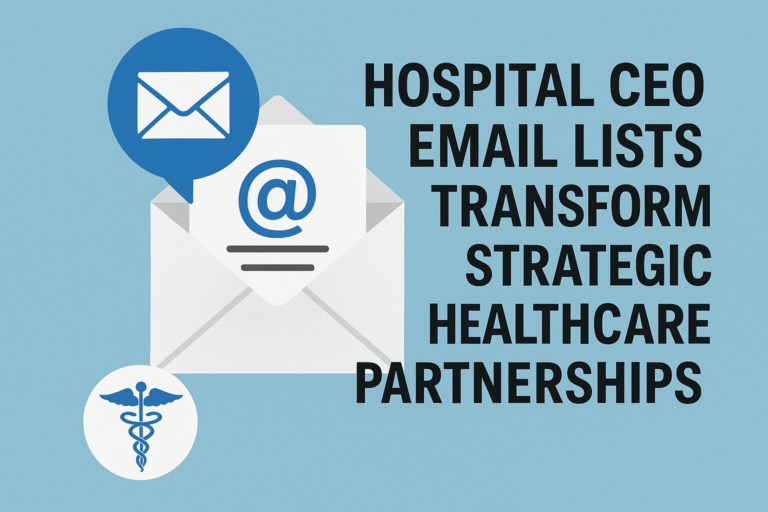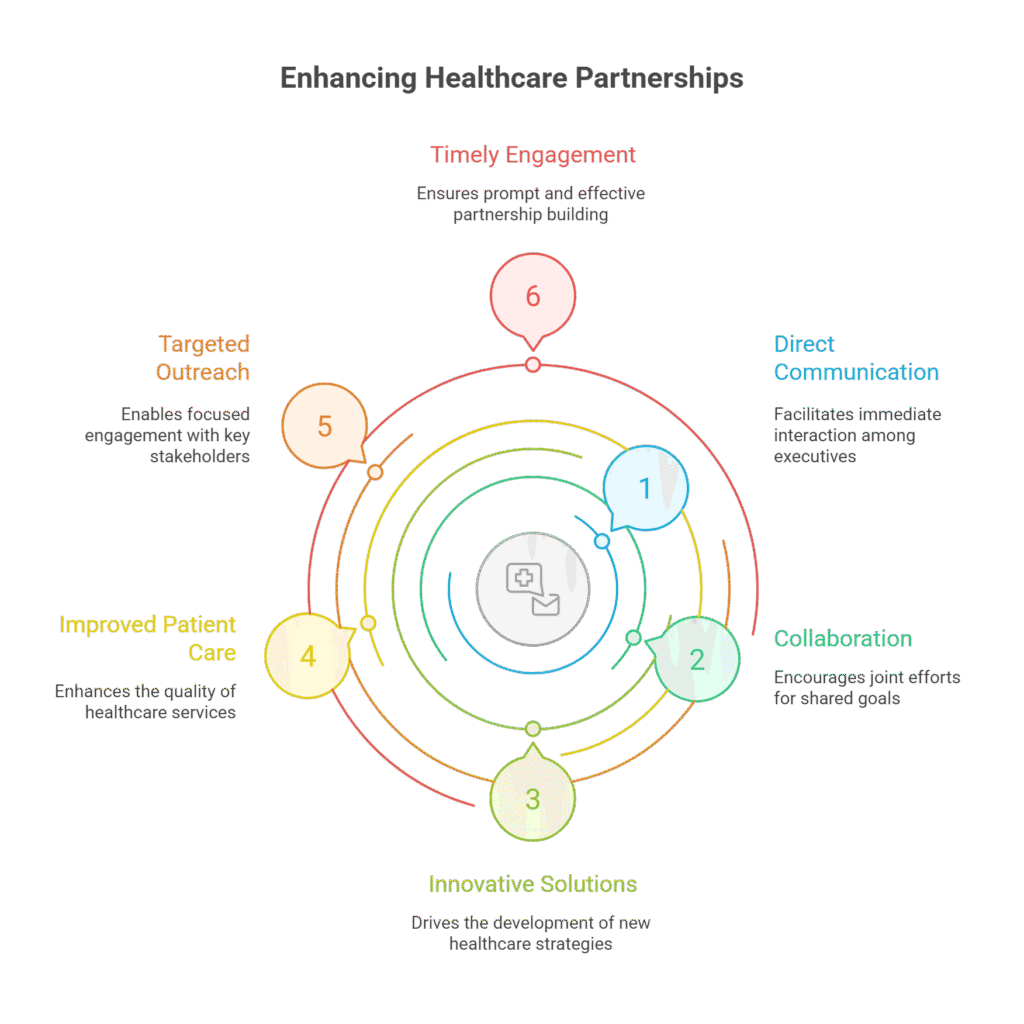
10 Ways Hospital CEO Email Lists Transform Strategic Healthcare Partnerships
In an increasingly interconnected yet competitive healthcare ecosystem, the ability to forge meaningful partnerships is no longer a luxury, but a strategic imperative. The complex web of healthcare providers, technology innovators, pharmaceutical giants, and medical device manufacturers demands direct and impactful communication to truly drive progress.
Yet, in this intricate landscape, reaching the ultimate decision-makers—hospital CEOs—often feels like navigating a labyrinth. Traditional outreach methods, while having their place, frequently fall short when it comes to securing the high-level engagement necessary for transformative collaborations.
This article will explore 10 transformative ways hospital CEO email lists empower healthcare businesses to cultivate strategic healthcare partnerships, accelerate growth, and drive innovation, providing actionable insights for effective engagement.
The Strategic Imperative of Direct CEO Access
The modern healthcare industry is characterized by rapid technological advancements, evolving regulatory landscapes, and an intensifying focus on patient outcomes and cost efficiency. For businesses operating in this space, securing a competitive edge hinges on their ability to adapt and innovate.
The Challenge of Traditional Outreach in Healthcare B2B
Many healthcare B2B marketing and sales efforts still rely on broad, untargeted campaigns or navigating complex organizational hierarchies. This often results in inefficiency and a low return on investment (ROI).

Generic marketing collateral, while informative, rarely captures the attention of high-level executives whose time is exceptionally valuable. Furthermore, the layers of gatekeepers within large hospital systems can make direct access to decision-makers an arduous and time-consuming process.
Why Hospital CEOs are Key Decision-Makers for Strategic Partnerships
Hospital CEOs sit at the apex of their organizations, possessing the authority to approve major initiatives and investments. Their vision for the hospital’s future direction, combined with their understanding of strategic needs and long-term goals, makes them indispensable partners for any organization seeking to introduce significant change or establish a lasting presence.
Their influence extends beyond their immediate institution, often impacting the broader healthcare ecosystem through industry leadership and collaborative ventures. Direct access to these executives can dramatically shorten sales cycles and foster truly impactful alliances.
The Power of Curated Hospital CEO Email Lists
Given the critical role of hospital CEOs, the strategic value of a meticulously assembled hospital CEO email list becomes clear. This isn’t merely a collection of contact information; it’s a powerful tool for precision engagement.
Defining “Curated”: Accuracy, Segmentation, and Compliance
A truly effective hospital CEO email list is defined by its accuracy, detailed segmentation, and strict adherence to compliance standards. The importance of up-to-date and verified data cannot be overstated; outdated or incorrect information leads to wasted effort and damaged credibility.
Furthermore, intelligent segmentation, allowing for filtering by hospital size, specialty, geographic location, and even specific challenges, enables highly targeted outreach. Crucially, any reputable list must adhere to stringent data privacy regulations, including HIPAA in the United States and GDPR in Europe, to ensure ethical and legal compliance.
Beyond Basic Contact Information: What a Good List Provides
A superior hospital CEO email list offers more than just an email address. It often provides insights into the hospital’s organizational structure, key initiatives, and even publicly available information about executive interests and pain points.
This deeper understanding allows for the crafting of highly relevant and compelling communication, transforming a simple email into a targeted conversation starter.
10 Ways Hospital CEO Email Lists Transform Strategic Healthcare Partnerships
Leveraging these specialized email lists can fundamentally alter how healthcare businesses approach B2B healthcare marketing and healthcare lead generation.
Way 1: Accelerated Decision-Making and Sales Cycles
A primary benefit of direct communication with hospital CEOs is the ability to bypass layers of bureaucracy that often bog down traditional sales processes. Sending a targeted email directly to the top allows for swift introduction of your value proposition to the ultimate authority.
For instance, a medical device company recently reported reducing its sales cycle by 25% after implementing a strategy of direct CEO engagement for their cutting-edge surgical robot. This direct line to key stakeholders significantly streamlines negotiations and approvals.
Way 2: Highly Targeted and Personalized Outreach
With a segmented hospital CEO email list, businesses can craft bespoke value propositions tailored precisely to the individual hospital’s strategic goals, current challenges, or specific patient demographics. Generic mass emails are easily dismissed; personalized messages, however, resonate deeply.
Data consistently shows that personalized emails have a 26% higher open rate compared to non-personalized ones, making them far more effective in capturing executive attention. This level of customization is crucial for effective hospital executive outreach.
Way 3: Enhanced Lead Generation Quality and Conversion
Instead of casting a wide net, hospital CEO email lists allow for focusing healthcare lead generation efforts on the highest-potential leads – those with the authority and vision to enact significant change. This precision dramatically reduces the time wasted on unqualified prospects and significantly improves conversion rates from initial contact to meaningful dialogue.
Way 4: Facilitating Strategic Alliances and Joint Ventures
Identifying potential partners for innovation and market expansion becomes more efficient when you can directly approach the leadership. A notable example is a leading healthcare technology company that successfully formed a joint venture with a major hospital system, focusing on AI-driven diagnostics.
This partnership, which began with direct CEO contact, has since led to the co-development of a new product and significant market share expansion, illustrating the power of direct engagement in fostering strategic healthcare collaborations.
Way 5: Driving Adoption of New Technologies and Solutions
Presenting cutting-edge solutions directly to those who can champion them is critical for healthcare technology adoption. CEOs are often at the forefront of strategic planning, seeking innovative ways to improve patient care, operational efficiency, and financial health.
Data consistently demonstrates that executive buy-in is a primary predictor of successful technology implementation within large organizations. A direct pitch can provide the necessary impetus for a new solution to gain traction.
Way 6: Informing Product Development and Market Entry Strategies
Gaining direct feedback from industry leaders provides invaluable insights that can shape product development and market entry strategies. For instance, a pharmaceutical company refined its R&D pipeline for a new oncology drug based on direct conversations with hospital CEOs, who highlighted unmet needs and specific patient population requirements.
These high-level insights ensure that new offerings are aligned with actual market demands, boosting their chances of success.
Way 7: Strengthening Brand Authority and Thought Leadership
Consistent, valuable communication with hospital executives through hospital CEO email lists can significantly strengthen your brand’s authority and establish your organization as a thought leader.
By sharing insightful research, industry trends, or solutions to common challenges, you position your company as a valuable resource and expert. This can also open doors for co-authored content, speaking engagements, and participation in industry panels, further cementing your reputation.
Way 8: Optimizing Resource Allocation and Marketing Spend
By focusing outreach efforts on a high-value segment, businesses can optimize their resource allocation and B2B healthcare marketing spend. This strategy avoids the inefficiencies of broad, untargeted campaigns, ensuring that marketing dollars are directed towards channels with the highest potential ROI. The precision of email list targeting translates directly into more effective and economical campaigns.
Way 9: Cultivating Long-Term Relationships and Trust
The goal of direct hospital executive outreach extends beyond immediate transactions; it’s about building long-term relationships based on trust and mutual benefit. Consistent, value-driven communication fosters rapport directly with executives, paving the way for sustained collaborations.
Delivering on promises and demonstrating a deep understanding of their challenges are key to nurturing these crucial relationships.
Way 10: Gaining Competitive Advantage in a Crowded Market
In the competitive healthcare industry, direct access to CEOs differentiates your outreach and value proposition. While competitors may struggle to get past gatekeepers, your ability to communicate directly can unlock exclusive opportunities and preferred partner status.
This strategic advantage is invaluable for medical device sales, pharmaceutical marketing, and other data-driven healthcare strategies.
Best Practices for Leveraging Hospital CEO Email Lists
Simply possessing a list is not enough; effective execution is paramount.
Crafting Compelling Email Content
The success of your outreach hinges on the quality of your email content. Subject lines must be concise and immediately convey value, compelling the executive to open. The body of the email should be equally concise, focused on the executive’s pain points and how your solution offers a clear benefit, not just features. Always include a clear call to action that is easy to understand and execute.
The Importance of Follow-Up and Relationship Nurturing
Persistence without being intrusive is key. A well-planned follow-up sequence demonstrates commitment and allows you to provide additional value. Focus on nurturing the relationship over time, offering insights, and demonstrating your ongoing commitment to their success.
Measuring Success and Adapting Strategies
Effective B2B healthcare marketing requires continuous analysis. Key metrics to track include open rates, click-through rates, and ultimately, conversion rates from email engagement to meetings or partnerships. Employ A/B testing for different subject lines, content formats, and calls to action to continually refine your approach and improve effectiveness.
Ethical Considerations and Compliance
Always respect privacy and promptly honor opt-out requests. Adhering to all relevant data protection laws and best practices is not just a legal requirement but also a fundamental aspect of building trust and maintaining a positive brand reputation within the healthcare ecosystem.
Final Thoughts
The ability to forge strategic healthcare partnerships is a cornerstone of success in today’s dynamic healthcare landscape. As we’ve explored, meticulously curated hospital CEO email lists offer a powerful, transformative tool for achieving this.
By enabling accelerated decision-making, highly targeted outreach, and the cultivation of long-term relationships, these lists unlock unparalleled opportunities for healthcare lead generation, healthcare technology adoption, and market expansion. The strategic advantages, from optimizing resource allocation to gaining a critical competitive edge, are undeniable.
Take the first step towards transforming your healthcare partnerships today. Invest in a meticulously curated hospital CEO email list and apply these strategies to unlock unparalleled growth and innovation within the dynamic healthcare landscape.